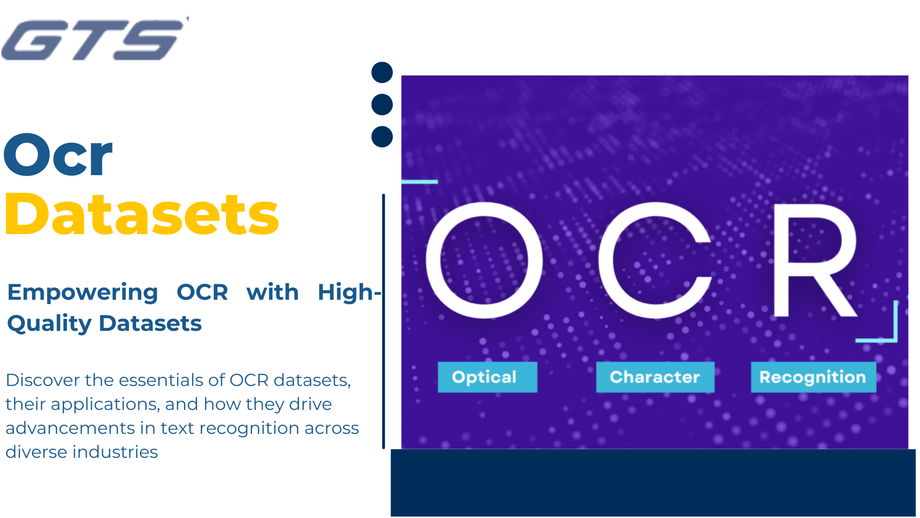Exploring OCR Datasets: A Key to Unlocking Text Recognition Potential
Introduction:
Optical Character Recognition is one of the most transformative technologies in the age of digitization. It has bridged the gap between human-readable content and machine learning systems by enabling machines to read and interpret text from images, PDFs, and other visual formats. For developers, researchers, and companies building OCR-powered applications, the availability of high-quality OCR Datasets plays a crucial role in achieving accurate and reliable results.
It addresses OCR datasets' relevance, their application, challenges faced, and features of an ideal dataset to learn and improve an OCR model with high precision.
What Are OCR Datasets?
OCR datasets are collections of annotated data created for training and testing OCR systems. These are typically composed of the following entities:
- Textual Images: Scanned documents, handwritten notes, photographs of any content.
- Annotations: Ground truth labels that declare the text content of images.
OCR datasets are very important for training machine learning models to recognize and extract textual information with accuracy. Developers can use these datasets to:
- Train models to decipher various fonts, sizes, and handwriting styles.
- Test systems for robustness in handling noisy or distorted text.
- Evaluate performance across different languages and scripts.
Applications of OCR Datasets
OCR datasets have various applications across different industries, which makes them inevitable in many fields:
- Document Digitization: Organizations around the world are digitizing physical records for easier storage and retrieval. OCR datasets aid in training models to extract text accurately from the following sources: Legal documents , Invoices , Academic papers
- Assistive Technologies: OCR capabilities enable different support devices for the visually impaired by converting written text into speech or Braille. Specific OCR datasets make such systems ready for reading text in specific environments.
- Banking and Finance: In banking, OCR facilitates direct processing of checks, invoices, and identity documents. Datasets annotated for financial materials help improve specific models in this domain.
- Language Translation and Localization: OCR datasets support multilingual OCR systems that can be applied in applications like automatic translation and real-time localization.
- E-commerce: From extracting product details in catalog images to analyzing receipts, OCR datasets are fundamental to the e-commerce platform.
Challenges in OCR Dataset Development
Building high-quality OCR datasets is a complex process, as it has to handle several challenges:
1. Data Diversity
The OCR system should be able to recognize:
- Multiple fonts and styles
- Variations in handwriting
- Multi-lingual and multi-script text
- Preparing datasets that have this diversity in them is very challenging.
2. Noise and Distortions
Real-world data contains distortions such as:
- Blurred or tilted images
- Low lighting or shadows
- Background clutter
- Good OCR datasets simulate these cases so that models are able to perform well on imperfect inputs.
3. Annotating Data
Accurate annotations are needed to train OCR models that can be trusted. However, text annotation in images is tedious and time-consuming.
4. Privacy Issues
Data sets containing personal information, like identity documents or medical records, raise privacy and compliance issues.
Characteristics of High-Quality OCR Datasets
To create or choose an OCR dataset that will suit the needs of a project, consider the following essential characteristics:
1. Diversity in Text Sources
A good OCR dataset should contain:
- Printed and handwritten text
- Multi-lingual text samples
- Text from various domains (e.g., legal, medical, and academic documents)
2. Realistic Conditions
Datasets should represent real-world conditions, such as:
- Noisy or low-resolution images
- Variety of lighting and environmental conditions
3. Comprehensive Annotations
Good-quality datasets should offer:
- Accurate bounding boxes for text regions
- Transcriptions for text content
- Additional metadata, like font type and size
4. Scalability
Large datasets with millions of annotated samples enable deep learning models to generalize better and achieve higher accuracy.
5. Ethical Compliance
OCR datasets must respect privacy regulations, such as GDPR, and avoid including sensitive or personally identifiable information without consent.
Future of OCR Datasets
As OCR technology advances, so does the need for specialized datasets. Future OCR datasets will most likely be about the following:
- Multimodal Data: The fusion of text, images, and contextual information for more comprehensive training.
- Real-Time Scenarios: Capturing dynamic environments, such as moving objects or live video streams.
- Advanced Annotations: Including semantic relationships, text structure, and hierarchical data.
Conclusion
The development of efficient text recognition systems depends on OCR datasets. They allow researchers and developers to train models capable of tackling complex OCR tasks across industries by providing diverse, annotated data. Building and maintaining high-quality datasets, however, is a challenging task that involves careful consideration of data diversity, annotation quality, and ethical compliance.
At Globose Technology Solutions Pvt. Ltd. (GTS), it is well acknowledged that datasets hold a crucial importance in machine learning. We hold expertise in collection of data regarding various domains which include OCR datasets that ensure your model gets the very best training material. Located at TC-321-325, R-Tech Capital Highstreet, Phool Bagh, Bhiwadi, Alwar (RJ.) - 301019, we would be more than happy to aid you with the dataset requirements of yours.
For any query, please contact to hi@gts.ai. or official website gts.ai Let's build advanced OCR solutions together!


